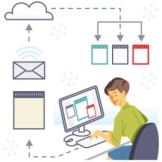 The Peer to Patent portal is a headline example of the potential of Open Government “in the Cloud”, and the first project that defined “Wiki Government”.
The Peer to Patent portal is a headline example of the potential of Open Government “in the Cloud”, and the first project that defined “Wiki Government”.
It illustrates how Open Government is not just about more open reporting for people to passively look at, it’s actually about re-engineering the process itself, to deliver considerable efficiency improvements and critically, enable more open public participation.
Using ‘Open Innovation‘ the site has transformed the process to apply for a patent from a “closed” version to an Open one that operates “in the Cloud”.
Pioneered by Open Government leader Beth Noveck, she provided a detailed case study of the thinking behind her project in this 40 page Harvard white paper. She describes how the agency was building up a huge backlog of patent applications due to a ‘closed’ approach where only staff from the USPTO could review, contribute and decide upon applications.
Not only did this cause a bottleneck due to the number of resources being utilised but also in terms of the volume and quality of subject matter expertise being applied. With no involvement from outside contributors, such as experts from the scientific community, then awards were being granted for applications based on very limited and often inaccurate knowledge.
By moving the workflow online to a Web 2.0 environment they have been able to “open up” the workflow to a distributed community of experts from across many different organisations, and apply collective efforts to increase both quality and speed.
Wiki Government
 Beth has since gone on to write a book, ‘Wiki Government’, that describes how the principles can be generalized and applied to all areas of Government.
Beth has since gone on to write a book, ‘Wiki Government’, that describes how the principles can be generalized and applied to all areas of Government.




Leave a Reply
You must be logged in to post a comment.